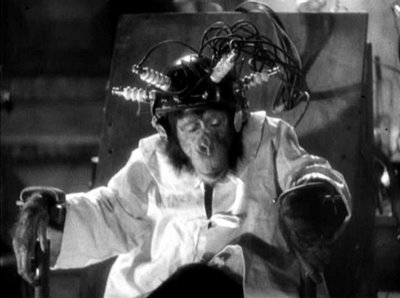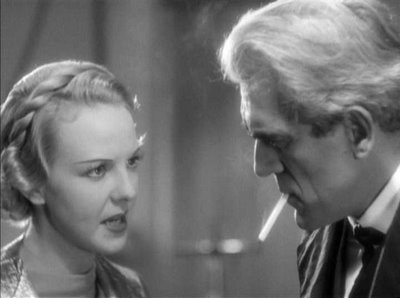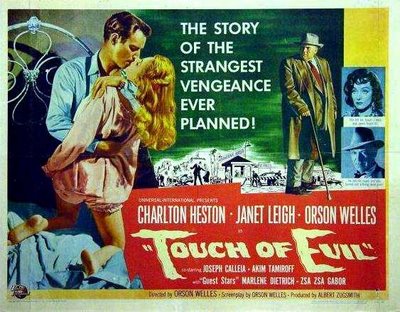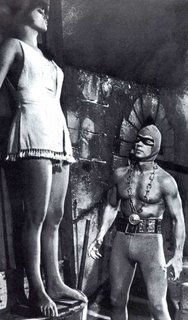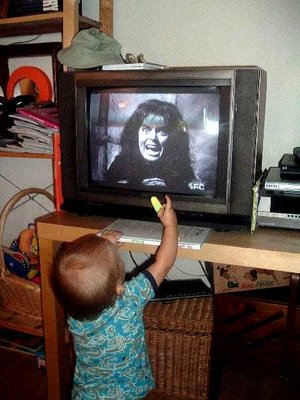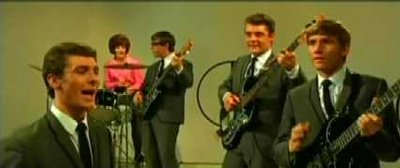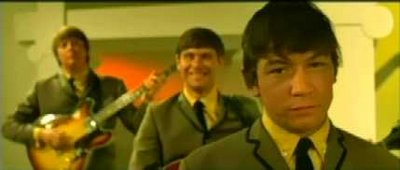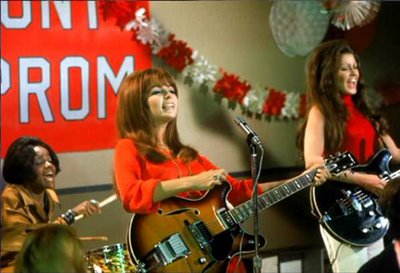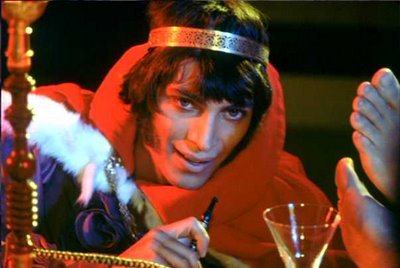 Before I go and forget the details, which I hastily scribbled down, I should make note of a surprise phone call I received a couple of days ago from Independent-International mogul, Samuel M. Sherman.
Before I go and forget the details, which I hastily scribbled down, I should make note of a surprise phone call I received a couple of days ago from Independent-International mogul, Samuel M. Sherman.Sam is a longtime friend of VIDEO WATCHDOG, and an even-longer hero of mine, not only for importing LA MARCA DEL HOMBRE LOBO (as FRANKENSTEIN'S BLOODY TERROR) and a number of the West German Edgar Wallace krimis, but also for his early editorship of SCREEN THRILLS ILLUSTRATED (in retrospect, the most reliable and well-written of all Warren film publications) and for his inimitable talents as a designer of exploitation film campaigns. It was Sam who created all the best-loved, blood-drooling Hemisphere Pictures trailers and ad campaigns; it was he who hired Brother Theodore to narrate the trailers for THE MAD DOCTOR OF BLOOD ISLAND and HORROR OF THE BLOOD MONSTERS; and I had also heard that Sam was responsible for some of the campaigns for Andy Milligan's movies. For my money, Sam was the King of Lurid Advertising.
Out of curiosity, I asked Sam if he had been responsible for the classic campaigns for Milligan's BLOODTHIRSTY BUTCHERS, TORTURE DUNGEON, and THE RATS ARE COMING! THE WEREWOLVES ARE HERE! -- but he said No; neither did he have anything to do with another William Mishkin release I'd heard he'd done, THE ORGY AT LIL'S PLACE. But my question prompted some very interesting information about the role Sam had played in Andy Milligan's early career. The following quote I have reconstructed from what I jotted down as Sam was reminiscing. All news to me, and I don't believe any of this was covered in Jimmy McDonough's book THE GHASTLY ONE, either:
Sam Sherman: "I first became aware of Andy Milligan when I was doing ad campaigns. My partner Bob Price and I did some work at that time for a distributor named Jerry Balsam, and one day, Jerry showed us a film called SIN SISTERS, 2000 A.D. It was a terrible, amateurish picture and I didn't think much better of the title. It was later retitled THE DEGENERATES, at my suggestion. After we saw it, we came up with a campaign built around this new title, which I believe was fairly successful. Somewhere around here, I have a book about the days of 42nd Street exploitation -- I don't remember the title -- but the picture on the cover of the book is a shot of a 42nd Street theater marquee with the title THE DEGENERATES on it. That was considered quite a strong title in those days; "DEGENERATES" was one of the words that some newspapers wouldn't print, so you'd have to call the theater to find out the title.
 "Later on, Andy Milligan bought this big house on Staten Island and started making pictures there. He also started shooting in color. The first picture he made there was a color film, a kind of Victorian story with a lot of sex in it. Jerry Balsam acquired it too, and he screened it for us. It had some thriller elements, but they didn't sit very well in the picture he had made. I suggested to Jerry and Andy that, if they really wanted a successful picture, they should go back and do some reshoots -- he still had the house, because he lived in it, and the cast were working cheaply if they were paid at all. I told them I thought they should rework it to be more of a horror picture. The film had this hunchback minion character [Hal Borske] who I thought should be played up a bit more, and it had too much sex in it, as it was. So Andy got the cast back together and shot some additional horror sequences with gore and what-not, cutting out a lot -- if not all -- of the sex and nudity. So, in a sense, I'm the person responsible for suggesting to Andy Milligan that he make horror pictures. That movie became THE GHASTLY ONES, which is also a title I suggested, because 'Ghastly' was a word that hadn't previously been used in the title of a horror movie; I thought it would be effective. I later used it again in the title for Al Adamson's BLOOD OF GHASTLY HORROR. The ad campaign for THE GHASTLY ONES was also one of mine; I did that with Bob Price."
"Later on, Andy Milligan bought this big house on Staten Island and started making pictures there. He also started shooting in color. The first picture he made there was a color film, a kind of Victorian story with a lot of sex in it. Jerry Balsam acquired it too, and he screened it for us. It had some thriller elements, but they didn't sit very well in the picture he had made. I suggested to Jerry and Andy that, if they really wanted a successful picture, they should go back and do some reshoots -- he still had the house, because he lived in it, and the cast were working cheaply if they were paid at all. I told them I thought they should rework it to be more of a horror picture. The film had this hunchback minion character [Hal Borske] who I thought should be played up a bit more, and it had too much sex in it, as it was. So Andy got the cast back together and shot some additional horror sequences with gore and what-not, cutting out a lot -- if not all -- of the sex and nudity. So, in a sense, I'm the person responsible for suggesting to Andy Milligan that he make horror pictures. That movie became THE GHASTLY ONES, which is also a title I suggested, because 'Ghastly' was a word that hadn't previously been used in the title of a horror movie; I thought it would be effective. I later used it again in the title for Al Adamson's BLOOD OF GHASTLY HORROR. The ad campaign for THE GHASTLY ONES was also one of mine; I did that with Bob Price."When I told Sam that THE DEGENERATES is now considered a lost film, he sounded surprised. "I know that Milligan's early Mishkin films are considered lost, but THE DEGENERATES was a Jerry Balsam picture, so there's no reason why it should be. Jerry's passed away, and he wasn't one for copyrighting his prints, so if they could be found, there wouldn't be anything to stop someone from just putting them out. You say it's a lost film; I don't know that it is, but if it is, I'd have to say it's just as well. Of course, horror fans are often completists and want to see as much as they can, and I understand this -- but it really was a terrible picture, very badly made."
 The reason Sam called me in the first place was because he had discovered a discussion folder I had created on the Latarnia International boards, called "The Mystery of Ivan Reiner," which can be found here. Reiner was the writer-producer behind the Gamma I films made by Antonio Margheriti and the Gamma III film THE GREEN SLIME, directed by Kinji Fukasaku; he was, as far as I can tell, their only common denominator, and so much more the "Gamma" man than Margheriti or anyone else. When I posted my original message, I was commemorating the 40th anniversary of his death, according to the IMDb... but, as Sam pointed out, those dates didn't jibe because it would have meant he was dead before THE GREEN SLIME was made! The thread petered out after only two replies, and there was even speculation that "Ivan Reiner" might be a pseudonym for the prolific Ennio Di Concini. Not so, says Sam Sherman.
The reason Sam called me in the first place was because he had discovered a discussion folder I had created on the Latarnia International boards, called "The Mystery of Ivan Reiner," which can be found here. Reiner was the writer-producer behind the Gamma I films made by Antonio Margheriti and the Gamma III film THE GREEN SLIME, directed by Kinji Fukasaku; he was, as far as I can tell, their only common denominator, and so much more the "Gamma" man than Margheriti or anyone else. When I posted my original message, I was commemorating the 40th anniversary of his death, according to the IMDb... but, as Sam pointed out, those dates didn't jibe because it would have meant he was dead before THE GREEN SLIME was made! The thread petered out after only two replies, and there was even speculation that "Ivan Reiner" might be a pseudonym for the prolific Ennio Di Concini. Not so, says Sam Sherman."I knew Ivan," Sam told me, "and I can tell you a little about him. He was, in fact, a New Yorker who lived in New York City and was originally the program director for WOR-TV, Channel 9, in Secaucus, New Jersey. He later worked with a film distributor by the name of Walter Manley, who had film distribution deals with companies all around the world, including the United States, Italy, and Japan. When I read your posting, I went to the IMDb -- which I often find runs riot with misinformation, though it is getting better. It said that Ivan had died back in the 1960s, which I knew wasn't true, so I went and looked up his name via the Social Security death records and found that he passed away sometime in September 1997. It also gave the date of his birth as 1911. I submitted this information to the IMDb and I hope it appears there, sooner or later."
I just checked Ivan Reiner's IMDb page and the correct information is indeed now posted there. My thanks to Sam for calling -- the mind boggles at the kinds of things he must know, but hasn't been asked about!

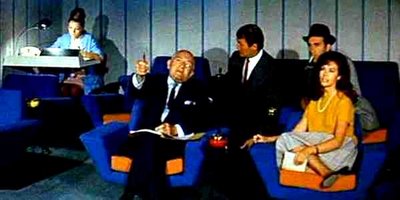
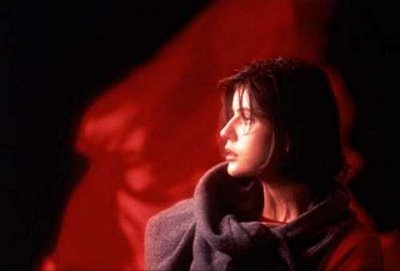


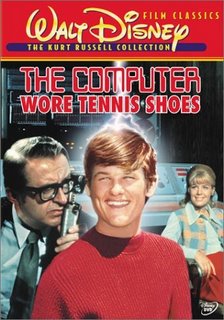
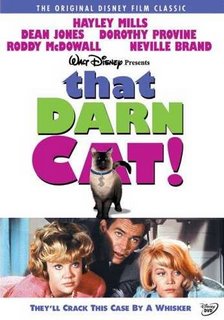 THAT DARN CAT!
THAT DARN CAT!


